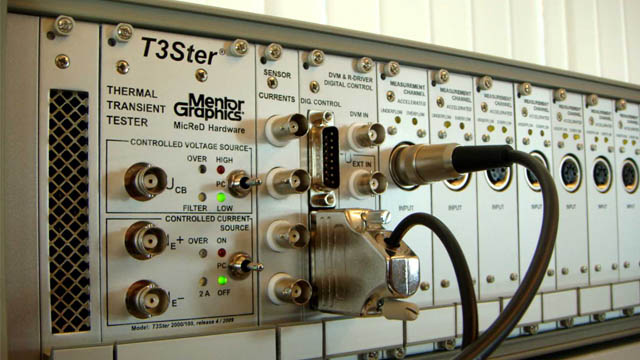
Simcenter™ T3STER™ (pronounced "Tris-ter") system is an advanced non-destructive transient thermal tester for thermal characterization of packaged semiconductor devices (diodes, BJTs, power MOSFETs, IGBTs, power LEDs) and multi-die devices, capable of testing components in situ. A proprietary system consisting of software and hardware, our solution supports the semiconductor, transportation, consumer electronics and LED markets.
Measuring the true thermal transient response is far more efficient than steady-state methods. Measurements are to ±0.01° C with up to 1-microsecond time resolution, producing accurate thermal metrics. Structure functions post-process the response into a plot that shows the thermal resistance and capacitance of package features along the heat flow path. Failures in the structure, such as faults in the die-attach failures are easily understood, making this an ideal pre- and post-stress failure detection tool in reliability analysis. Measurements can be exported for thermal model calibration, underpinning the accuracy of the thermal design effort.
9 Key Simcenter T3STER Strengths
Simple& Easy
Measuring with Simcenter T3STER is very easy. Fix the sample to the desired thermal environment, connect it through electrical wires to the tester, similarly to the normal operating conditions in case of discrete devices such as diodes, LED-s or transistors. Even complex digital IC-s can be tested through their substrate diodes, using 4 wires.
The software provides guidance for the connections to make the system more easy to learn and use.
Repeatable& Reproducible
Simcenter T3STER provides both repeatable and reproducible test results. Repeated measurements on the same sample will provide the same test data over and over again, eliminating the need for multiple test runs and averaging in most standard situations. This saves valuable testing time.
Simcenter T3STER measurements are reproducible as well. Measuring the same sample with any calibrated Simcenter T3STER system we produce will always provide comparable test results. This makes Simcenter T3STER measurements a 'common language' among different test groups and organizations when they share and compare information on semiconductor thermal performance.
Wide Variety of Semiconductor Components
Simcenter T3STER can test most common semiconductor types, diodes, MOSFET-s, IGBT-s, digital VLSI IC-s and more. Our engineering team is always keen on finding suitable test approaches for more 'exotic' devices if necessary.
Insight into Thermal Structure
The thermal transient response curves are used for further analysis after Simcenter T3STER measurements. Our Simcenter T3STER-Master software provided with the hardware can convert the thermal responses into structure functions, which describe the heat-flow path from the semiconductor junction to the ambient. Structure functions have multiple use, can help define standard thermal metrics, such as RthJC, RthJA, can help comparison among different material choices or support failure analysis by highlighting potential structural errors in key thermal interface layers in a semiconductor package and its thermal environment.
Fast Throughput (non-Repetitive)
Simcenter T3STER measurements are fast, as fast as the physical properties of a device allow. Using the JEDEC JESD 51-1 static test method, Simcenter T3STER will heat up a component once, then capture the cooling curve in real time, as the device cools down. Due to the excellent signal-to-noise ratio, it is enough to capture the response curve only once. It is safe to say that Simcenter T3STER applies the fastest test methodology possible.
Non-Destructive
Simcenter T3STER measurements are non-destructive. After taking a test on a sample, in every case the sample remains operational. This allows Simcenter T3STER tests to be used in quality check, or even makes monitoring and sorting of actual production units based on their thermal performance.
Tests Components in Situ
Simcenter T3STER allows in-situ tests, it can measure the thermal performance of samples in their native, operational environment, no matter it is air cooling, cold plate mounting, a water jacket, or a component on a PCB. Our technology does not use thermocouples nor requires opening up the package as IR tests would do. This way we test the true thermal performance without distracting the thermal boundary conditions even to the slightest extent.
Test-Based Compact Thermal Models
Structure functions calculated based on Simcenter T3STER test results are thermal R-C network models. Cutting the model at the case node of the component provides a 1D thermal behavior model of the tested package. Exporting this model to Simcenter Flotherm™ or Simcenter FLOEFD™ allows a quick and reliable method to generate a test based thermal model and simulate its behavior in a complex 3D CFD environment. This method is recommended for discrete power semiconductor packages, such as TO-220, TO-247 or common LED packages.
Detailed Thermal Model Calibration
For more accurate simulations, a detailed 3D equivalent of the package is the best, generic option. Simulation results are however as accurate as the model itself, any modeling error in material properties or geometry can result in inaccurate simulation data. Unfortunately material properties of thermal interface layers are often uncertain parameters even for component makers. Using Simcenter T3STER measurements as reference, our Simcenter Flotherm and Simcenter FLOEFD tools can calibrate component models to create true digital twins of the real component to achieve utmost modeling accuracy. Once the component model is calibrated to Simcenter T3STER tests, it should behave as the real physical sample for any arbitrary power input, making even complex transient simulations highly accurate.


